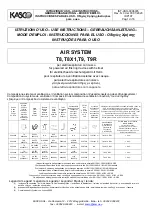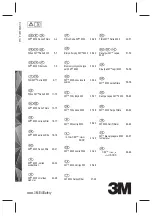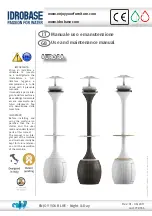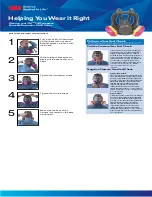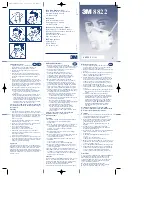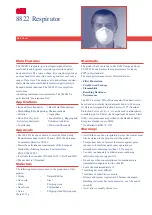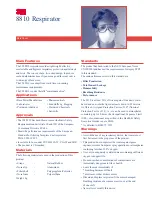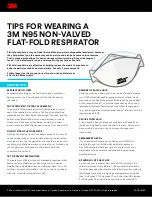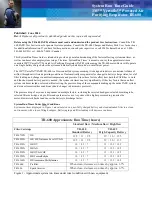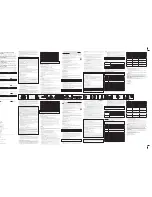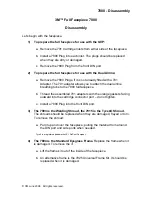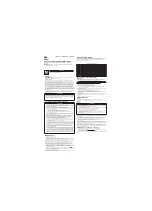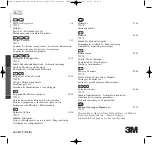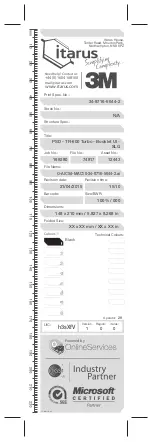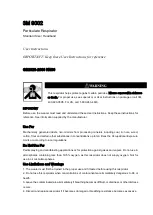
ISTRUZIONI D’USO – USE INSTRUCTIONS –
GEBRAUCHSANLEITUNG – MODE D’EMPLOI -
INSTRUCCIONES PARA EL USO - Οδηγίες Χρήσης-Instruções
para o uso
IST-USO-0906005
Rev. N. 0 del 31/01/2020
IDP107
Pag.5 di 16
ENGLISH
1. DESCRIPTION.
1.1 HELMET:
AirSystem must be used in conjunction with a helmet:
Helmet
Airsystem
K80S (code 0302037)
T8 ZA2P3 (code 0324031), T9 ZA2P3 (code
0324029), T9R ZA2P3 (code 0324030)
K80 (code 0302035)
T8 ZP3 (code 0324040)
K80E (code 0302021),
T8X1 ZP3 (code 0324041)
1.2 BLOWER UNITS: They are composed of an ABS case with socket and ON/OFF
switch; a fan unit actuated by an electric micro motor. The T8X system include an
electronic air flow indicator with acustic alarm.
1.3 HOSE ASSEMBLY:
1.3.1 For K80 - K80E helmets: it consists of a spiraled hose enclosed by
smooth plastic for easy decontamination.
1.3.2 For K80S helmets: it consists of a corrugated hose with fittings for
helmet-blower unit connection.
1.4 BATTERY ASSEMBLIES:
1.4.1-LI-870: the pack consists of rechargeable lithium batteries in a sealed ABS housing
with non reversible plug; a circuit protection against short-circuits and over-discharge.
1.4.2 NM300 / 8 battery ass.y (built into T9R blower): It is composed of 8 NI-MH batteries
connected in series.
1.5 FILTERS
1.5.1 ZP3 FILTER: The letter “R” marked on the filter shows that the dust filter or filtering
part of a combined filter can be used for more than one working shift after exposure to
aerosols; the letters ”NR” indicate that the use is strictly limited to one working shift.
The filter is made of micro porous technical paper finely pleated with normalized EN
148-1 thread ( see filter use instruction).
1.5.2 ZA2P3 FILTER: it is made of 2 parts - the first of finely pleated submicron technical
paper and the other of activated carbon.
Connection: Thread - meets EN 148-1 standard requirements (see use instructions)
1.6 AIRFLOW INDICATORS:
1.6.1 ELECTRONIC INDICATOR - with audible alarm : mounted on the T8X blower unit for
the powered respirators with K80E helmets.
1.6.2 SPHERE TYPE INDICATOR : for the powered respirators with K80 and K80S
helmets.
2.TECHNICAL FEATURES
2.1
NOISE LEVEL: < 75 dB.
2.2 SPECIFICATIONS:
Product
code
AIR SYS
TEM
Mi
ni
mu
m
declar
ed
air
flow
[l/m
in]
blower
unit
lif
e
[h
]
Rat
ed
volt
age
[V
]
Type
of
re
char
geable
ba
tte
ry
Aut
onom
ia
bat
te
ria
[h
]
E
sti
ma
te
d
ba
tte
y
lif
e
0324029
T9 ZA2P3
120
600
12
Direct power
supply
N.A
N.A
0324030
T9R ZA2P3
120
600
12
Direct power
supply
N.A
N.A
9,6
NiMh
3000 mA/h
> 2
2 years
or 300
cycles
0324031
T8 ZA2P3
120
1000
7,4
Lithium
8700 mAh
>8
2 years
or 300
cycles
0324040
T8 ZP3
120
1000
7,4
Lithium
8700 mAh
>8
2 years
or 300
cycles
0324041
T8X1 ZP3
160
1000
7,4
Lithium
8700 mAh
>8
2 years
or 300
cycles
3. OPERATION
3.1 The blower unit, powered by rechargeable battery, takes in air through the filters and
sends it, via hose, to the inside of the helmet. The helmet goes into slight positive over
pressure and the wearer breathes filtered air only. Expired air is expelled through the
diaphragm valves.
4.
USE
4.1
The powered respirators are designed for the protection of the respiratory tract
of the wearer and not for other risks such as the protection of the face or eyes.
a)Some uses
for
which the AIR SYSTEM kit in combination with the K80S / K80 / K80E
helmet for the protection of the respiratory system against
solid and liquid aerosols
(ZP3
filter
)
are designed
• Agriculture: Cleaning stables, pens and coops.
Handling and processing grains and fodder
• Chemical and: pharmaceutica, Chemical dusts, formulations and pastes; Biohazardous
operations and infectious diseases.
• Construction, building and renovation: Cutting / polishing / grinding / drilling of
concrete, stone, masonry; Plaster; Painting and surface coating; Masonry work and
renovations; Controlled demolition
• Metal working, Mechanical machining and scrapping,
• Wood working, Cutting / bending / drilling / sanding; Adhesive removal via scraping and
sanding,
• Working with fibreglass and minerals: Mineral mining and marble working.
• Painting: Powder coating and spraying.
b)against solid and liquid aerosols, organic gases and vapors (with ZA2P3 filters):
• Agriculture: Mixing / spraying of pesticides, fungicides, herbicides; Spraying and weeding
using tractor/ service machine; Spraying and weeding using knapsack sprayers; Pesticide
treatments (vineyards, orchards, cereals,nuts, etc.); Pesticide treatments in greenhouses
and nurseries; Disinfestation
•
Construction, building and renovation:
Painting and surface coating.
• Waste Management: Refuse handling and disposal.
• Wood working: Glueing
• Working with fibreglass and minerals: Blending/mixing and tile laying; Spraying.
• Maintenance: Disinfection and cleaning.
• Painting: Gardening Spray painting / coating with latex paint.
4.2 LIMITATIONS
a) Do not use in atmospheres immediately dangerous to life or health.
b) Do not use against gas and vapors if the respirator is fitted only with dust filters.
c) Do not wear for protection against gases, vapours, carbon monoxide, natural gas and
fumigants.
d) Do not use for protection against fire smoke.
e) Do not use in closed environments (tanks, silos etc.).
f) Do not use in atmospheres containing less than 17% oxygen.
g) Do not use in explosive atmospheres.
h) Do not use against dangerous powders when the concentration in the environment is
higher than that required by the EN 529 standard
i) Do not use in IDLH environments (situations immediately dangerous to the life or health of
the operator).
5.
USE INSTRUCTIONS
5.1 BATTERY CHARGING:
5.1.1 LI-870 BATTERIES:
Charging of the rechargeable Lithium battery must be done exclusively with the
KASCO LI-02 battery charger (see use instructions packed with the respirator).
Recharge time: 3 hours
RECHARGE THE BATTERY AFTER EACH USE.
5.1.2 NM-300/8 BATTERY:
The built-in battery can be recharged with the KASCO Z15/220 battery charger .
The built-in battery recharge can be done in the following ways:
a) with blower Off and tractor not running (about 14 hours to charge)
b) with tractor running and blower unit switched either ON or OFF indifferently
c) with Z15/220 battery charger and blower unit in the OFF position. Recharge time:
about 14 hours
STORE THE BATTERIES ALMOST COMPLETELY DISCHARGED WITH BLOWER
UNIT SWITCHED OFF AND THE CORD UNPLUGGED FROM THE BLOWER.
5.2 PREPARING THE RESPIRATOR:
5.2.1 T8 / T8X BLOWER UNITS:
a)
Slip the belt through the battery and blower hook .
b)
Connect the battery to the blower with the cord and screw tight to make contact.
c)
Make sure that the unit is ON and running properly.
d)
Make sure that the filter gasket is properly inserted into the filter housing.
e)
Before using the filter for the first time check the expiry date to make sure the filters
have not expired; make sure that seals have not been broken and that the filters are
the correct ones for the respirator model in use.
f)
Remove covers from the filter and screw the EN148-1 threaded connection end onto
the chosen respirator. Read the filter use instructions.
5.2.2 T9R AND T9 WITH SP9 CORD:
a)
Plug the proper cord into the cigarette lighter socket located on the tractor dashboard
and connect to the blower .
b)
Make sure that the blower unit is running properly.
c)
Make sure the filter gasket is properly inserted in the housing.
5.2.3 FILTERS:
a)
Before using the filter for the first time check the expiry date to make sure the filters
have not expired; check that the seals are intact and that the filters are the proper
ones for the respirator model in use. Take care not to confuse the markings on the
filters with those of other standards which classify this RPD according to EN
12941:98+A1/03+A2/08.
b)
Remove covers and/or seals and screw the EN148-1 threaded end of the filter onto
the respirator. Read the filter use instructions.
6
MAINTENANCE
6.1
HELMET:
a)
Clean shell with organic solvent free detergent or with soapy water only.
b)
Clean visor with soapy water.
c)
Wash collar with warm soapy water.
6.2 BLOWER UNITS:
a) The motor does not require servicing.
b) Clean unit with organic solvent free detergents or with a cloth dipped into a 50%
water/ ethyl alcohol solution.
6.3 LITHIUM BATTERIES:
a)
The battery does not require servicing or tipping-up.
b)
RECHARGE IMMEDIALETELY AFTER USE FOR MAXIMUM BATTERY
EFFICIENCY .
c)
DO NOT KEEP THE BATTERIES DISCHARGED. IN CASE OF DEFAULT
CHECK THE VOLTAGE. BATTERIES ARE EQUIPPED WITH A PROTECTION
CIRCUIT THAT CUTS THE POWER OFF IN CASE OF CURRENT
OVERLOAD.
d)
If you plan to store the battery for long periods of time make sure it is at least
50% charged before storage. Do not keep the battery completely discharged for
longer than six months.
6.4 NM300/8 BATTERIES:
a)
The battery does not require servicing or tipping up.
b)
After a long storage period repeat the charge-discharge cycle 5 times to bring
the battery up to its original capacity.
c)
Store batteries almost completely discharged with the helmet switch OFF.
6.5 FILTERS:
a)
If sealed, the filters remain unaltered until the expiry date shown on them.
b)
Unsealed filters have to be replaced every three months, regardless of the
amount of hours worked. It is advisable to write the date on which the filter was
opened on the filter itself.
c)
Filters cannot be washed, blown out or restored. When exhausted they must be
disposed of.
d)
Replace both filters simultaneously.
e)
The respirator is to be serviced at least once a year by KASCO or Kasco a
authorised service centre.
7
CAUTION
7.1 Do not use the respirator in the conditions listed at point 4.2.
7.2 Do not immerse unit in water for cleaning without appropriate caps and covers.
7.3 Do not expose battery to heat sources of over 55°C.

